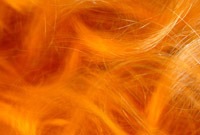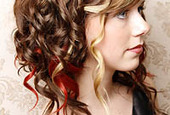What if the color doesn't turn out the way I wanted?
 If your hair color doesn't turn out the way you want then there may be things you can do to adjust your new hair color, but you should be aware that they depend largely on the kind of hair color initially used (permanent or temporary— see below) as well as the health of your hair. Also, if you're attempting to change a permanent hair color the stripping process needed can leave you with damaged hair. Each case, however, is different, so you really need to speak to your hairstylist about what to do in your specific case.
If your hair color doesn't turn out the way you want then there may be things you can do to adjust your new hair color, but you should be aware that they depend largely on the kind of hair color initially used (permanent or temporary— see below) as well as the health of your hair. Also, if you're attempting to change a permanent hair color the stripping process needed can leave you with damaged hair. Each case, however, is different, so you really need to speak to your hairstylist about what to do in your specific case.
The best solution to worrying about the possibility that your new hair color may not turn out the way you wanted is really just to prevent that happening in the first place— in other words, make sure your hair color turns out exactly the way you expected. This is something you can do by having an in-depth consultation with your hairstylist or your hair coloring specialist. That way you can talk it through, look at some examples, and do a strand test to see how things will turn out.
Is coloring my hair bad for healthy hair?
 It really depends on the condition of your hair to begin with and the kind of color you intend using. If your hair is dry, brittle and damaged before you apply any hair color then the process will probably make your hair worse. If your hair is already in good condition then some hair coloring process are likely to do less damage than others. Bleaching (to lighten the hair) is the harshest process because the bleach kills the hair's natural color molecules and, in turn, dries the hair out. Bleach also keeps working the longer you leave it on your hair (up to about 45 mins), meaning that the process needs to be timed correctly or else serious damage can be done. Permanent hair color doesn't remain active, so things can't go as wrong as they can with bleach, but it strips the color similar to the way bleach does and can dry your hair out too. Semi-permanents are the least damaging processes if you feel like coloring your hair (since they're not permanent and wash out eventually) and they even sometimes coat and protect the cuticle from harmful sun and heat appliances.
It really depends on the condition of your hair to begin with and the kind of color you intend using. If your hair is dry, brittle and damaged before you apply any hair color then the process will probably make your hair worse. If your hair is already in good condition then some hair coloring process are likely to do less damage than others. Bleaching (to lighten the hair) is the harshest process because the bleach kills the hair's natural color molecules and, in turn, dries the hair out. Bleach also keeps working the longer you leave it on your hair (up to about 45 mins), meaning that the process needs to be timed correctly or else serious damage can be done. Permanent hair color doesn't remain active, so things can't go as wrong as they can with bleach, but it strips the color similar to the way bleach does and can dry your hair out too. Semi-permanents are the least damaging processes if you feel like coloring your hair (since they're not permanent and wash out eventually) and they even sometimes coat and protect the cuticle from harmful sun and heat appliances.
While it's true that some hair coloring processes can damage your hair you can prevent too much damage by speaking to your hairdresser before you color your hair and also by working out a suitable after color hair care routine.
I'm fair skinned. Will dark hair make me look sickly and pale?
 No: it isn't true that dark hair will make fair skinned people look sickly and pale (and saying that's a bit insulting to fair skinned people with naturally dark hair too). Darker hair can look great on fair/cool and olive skin tones, and for proof take a look at pictures of Catherine Zeta-Jones and Angelina Jolie. A rule of thumb for all hair coloring is to stay within three or four shades of your natural hair color because otherwise— while you won't necessarily look "sickly"— you may look a little odd.
No: it isn't true that dark hair will make fair skinned people look sickly and pale (and saying that's a bit insulting to fair skinned people with naturally dark hair too). Darker hair can look great on fair/cool and olive skin tones, and for proof take a look at pictures of Catherine Zeta-Jones and Angelina Jolie. A rule of thumb for all hair coloring is to stay within three or four shades of your natural hair color because otherwise— while you won't necessarily look "sickly"— you may look a little odd.
Another thing to remember about changing your hair to a darker shade if your skin complexion is on the fairer side of the spectrum is that dark hair will probably draw attention to your skin— which means you could get a little self-conscious if you have a few blemishes or skin ailments.
Help! I hate my black hair. How can I change it back?
 Changing artificially colored black hair back to its natural color is possible but it's a difficult task that can cause significant damage to your hair. To revert back to your natural hair color you need to grow your roots about two inches so your hairstylist can see your natural hair color. Then the artificial color needs to be stripped off the hair and a similar tone to your natural color deposited in its place. The result— even though your hairstylist can be very careful and apply deep conditioning treatments after the process— is that your hair can be left quite dry and damaged.
Changing artificially colored black hair back to its natural color is possible but it's a difficult task that can cause significant damage to your hair. To revert back to your natural hair color you need to grow your roots about two inches so your hairstylist can see your natural hair color. Then the artificial color needs to be stripped off the hair and a similar tone to your natural color deposited in its place. The result— even though your hairstylist can be very careful and apply deep conditioning treatments after the process— is that your hair can be left quite dry and damaged.
I like the platinum blonde look. Will it ruin my hair?
It won't ruin your hair, but it can dry your hair out. The reason is because achieving platinum blonde hair color basically involves stripping all the color tone out of your hair. Bleach is the key ingredient in the lightening kit used and it's mixed with an activator (peroxide) that gets the bleach inside the hair shaft which then dilutes all the color molecules in your hair. The more color molecules that are diluted, the lighter your hair will become, and since platinum blonde color is the lightest color you pretty much have to dilute them all! If you have dry or damaged hair to begin with then the result can be a disaster. If it's not, and to keep your hair healthy after the bleaching process, you need to regularly use spray in conditioners and conditioning treatments and hair care products specially designed for colored hair need to be used (these can prevent brassiness); also, always use heat protection treatments before using all heating appliances.
What's the difference between permanent, semi-permanent and temporary hair color?
 Permanent hair color doesn't wash out (but needs to grow out— meaning you'll get regrowth) while semi-permanent and temporary hair color fades after about 6-12 washes. For an idea of the harshness of these processes on your hair and whether or not they may cause damage, see the question above: "Will coloring my hair ruin my hair?".
Permanent hair color doesn't wash out (but needs to grow out— meaning you'll get regrowth) while semi-permanent and temporary hair color fades after about 6-12 washes. For an idea of the harshness of these processes on your hair and whether or not they may cause damage, see the question above: "Will coloring my hair ruin my hair?".
Is coloring my hair myself at home a big mistake?
 You're using the same chemicals so the risk of damaging your hair if you color it yourself at home is pretty much the same as in the salon; although if you're using bleach (remember: it remains active for up to about 45 mins—see above) you can really stuff your hair up if you don't know what you're doing and you don't time it correctly. So ask a professional!
You're using the same chemicals so the risk of damaging your hair if you color it yourself at home is pretty much the same as in the salon; although if you're using bleach (remember: it remains active for up to about 45 mins—see above) you can really stuff your hair up if you don't know what you're doing and you don't time it correctly. So ask a professional!
With adequate preparation and good hair color advice it's possible to color your hair yourself at home and get a good result. Beware though: the hardest thing to get right is a nice even hair color all over your head. Often it's difficult to effectively spread the color to the tips of your hair and to hard to reach places, meaning the end result can sometimes be a little patchy.
If you have another hair color question, check out some of our other hair color and hair care articles, or ask one of our professional hairstylists yourself, right here.





